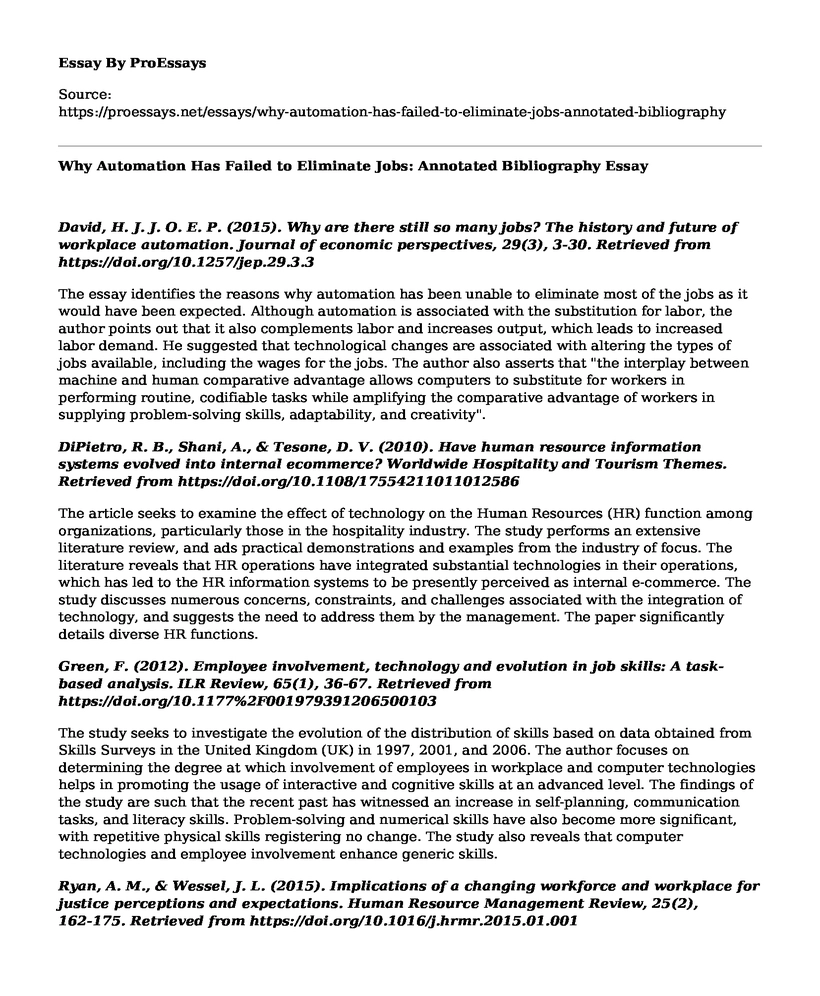David, H. J. J. O. E. P. (2015). Why are there still so many jobs? The history and future of workplace automation. Journal of economic perspectives, 29(3), 3-30. Retrieved from https://doi.org/10.1257/jep.29.3.3
The essay identifies the reasons why automation has been unable to eliminate most of the jobs as it would have been expected. Although automation is associated with the substitution for labor, the author points out that it also complements labor and increases output, which leads to increased labor demand. He suggested that technological changes are associated with altering the types of jobs available, including the wages for the jobs. The author also asserts that "the interplay between machine and human comparative advantage allows computers to substitute for workers in performing routine, codifiable tasks while amplifying the comparative advantage of workers in supplying problem-solving skills, adaptability, and creativity".
DiPietro, R. B., Shani, A., & Tesone, D. V. (2010). Have human resource information systems evolved into internal ecommerce? Worldwide Hospitality and Tourism Themes. Retrieved from https://doi.org/10.1108/17554211011012586
The article seeks to examine the effect of technology on the Human Resources (HR) function among organizations, particularly those in the hospitality industry. The study performs an extensive literature review, and ads practical demonstrations and examples from the industry of focus. The literature reveals that HR operations have integrated substantial technologies in their operations, which has led to the HR information systems to be presently perceived as internal e-commerce. The study discusses numerous concerns, constraints, and challenges associated with the integration of technology, and suggests the need to address them by the management. The paper significantly details diverse HR functions.
Green, F. (2012). Employee involvement, technology and evolution in job skills: A task-based analysis. ILR Review, 65(1), 36-67. Retrieved from https://doi.org/10.1177%2F001979391206500103
The study seeks to investigate the evolution of the distribution of skills based on data obtained from Skills Surveys in the United Kingdom (UK) in 1997, 2001, and 2006. The author focuses on determining the degree at which involvement of employees in workplace and computer technologies helps in promoting the usage of interactive and cognitive skills at an advanced level. The findings of the study are such that the recent past has witnessed an increase in self-planning, communication tasks, and literacy skills. Problem-solving and numerical skills have also become more significant, with repetitive physical skills registering no change. The study also reveals that computer technologies and employee involvement enhance generic skills.
Ryan, A. M., & Wessel, J. L. (2015). Implications of a changing workforce and workplace for justice perceptions and expectations. Human Resource Management Review, 25(2), 162-175. Retrieved from https://doi.org/10.1016/j.hrmr.2015.01.001
The study seeks to make forecasts of how HR research and HRM research practice on fairness in the workplace needs to be transformed on the basis of numerous global trends affecting workplaces. These trends include increased service-related jobs, individualized psychological contracts, technology-mediated relationships, as well as an increase in globalization and workplace diversity. Following the description of the four trends, the authors embark on illustrating how the fairness meaning and expectation of workers with regards to fairness may change in response. More importantly, the study examines how changes influence human resource management.
Sokoloff, J. (2012). Information literacy in the workplace: Employer expectations. Journal of Business & finance librarianship, 17(1), 1-17. Retrieved from https://doi.org/10.1080/08963568.2011.603989
The article seeks to close the gap between academic information literacy research and the perception of information literacy as a workplace skill. The study findings are based on qualitative inquiries obtained from corporate managers, which results in numerous recurring themes that relate to the use of information at the workplace. The study also identifies how competencies in information use are acknowledged in workplace settings, including how professionals at entry-level are prepared towards locating and utilizing information relevant to their workplace responsibilities.
Vaast, E., & Kaganer, E. (2013). Social media affordances and governance in the workplace: An examination of organizational policies. Journal of computer-mediated communication, 19(1), 78-101. Retrieved from https://doi.org/10.1111/jcc4.12032
The study performs an examination of the way in which firms view social media affordances as well as how they react to the way employees utilize social media via organizational governance and policies. The study identified four affordances derived from existing literature, which include editability, persistence, visibility, and association (between individuals and between individuals and information). These affordances are considered to be potentials of actions in social media usage among organizations. Study findings showed that persistence and visibility affordances were more reacted to in organizations relative to the editability affordance. Moreover, the article also found that the reactions of organizations to social media underwent significant evolution from being majorly concerned with the management of risks towards consideration of its value-generation potential.
Cite this page
Why Automation Has Failed to Eliminate Jobs: Annotated Bibliography. (2023, Apr 08). Retrieved from https://proessays.net/essays/why-automation-has-failed-to-eliminate-jobs-annotated-bibliography
If you are the original author of this essay and no longer wish to have it published on the ProEssays website, please click below to request its removal:
- Disruptive Technology and Final Paper - Management Essay Example
- Should Children Carry Cellphones in School? Essay
- Questions and Answers Essay on Apple's Problems
- Essay Example on Diffusion of Innovation: The 5-Stage Process
- Developing West: Gains and Glitches in Global GDP - Essay Sample
- Essay Example on Accelerating Energy Transitions for Clean, Efficient, and Safe Energy
- China's Tech Innovation: Race to the Top of the Digital Space - Research Proposal







